The Undrained Behaviour of an Air-Fall Volcanic Ash
Abstract
1. Foreword
2. General Features of Air-Fall Volcanic Ashes in Campania
3. An Investigation on the Undrained Strength of the Cervinara Volcanic Ash
3.1. Materials and Methods
3.2. Experimental Results and Interpretation
- due to the role of the intermediate principal stress, which in CIU_c tests is equal to the minor principal stress and in CIU_e tests is equal to the major principal stress, the slope Me of the SSL in the CIU_e tests is less than the slope Mc in CIU_c tests. As shown in Figure 8, in this case the difference between Mc and Me is even higher than the theoretical value since the friction angle measured in extension tests (φ’e = 36°) is slightly less than the value obtained in compression tests (φ’c = 38°);
- instability lines result also from the stress paths obtained in triaxial extension tests; in this case too, the slope of the IL depends on the void ratio.
4. Conclusions
Author Contributions
Funding
Acknowledgments
Conflicts of Interest
References
- Anderson, S.A.; Sitar, N. Analysis of rainfall-induced debris flow. J. Geotech. Eng. 1995, 121, 544–555. [Google Scholar] [CrossRef]
- Sassa, K. Mechanism of flows in granular soils. In Proceedings of the GeoEng 2000, an International Conference on Geotechnical & Geological Engineering, Melbourne, Australia, 19–24 November 2000; pp. 1671–1702. [Google Scholar]
- Zhang, D.; Wang, G.; Luo, C.; Chen, J.; Zhou, Y. A rapid loess flowslide triggered by irrigation in China. Landslides 1995, 6, 55–60. [Google Scholar] [CrossRef]
- Sladen, J.A.; D’Hollander, R.D.; Krahn, J. The liquefaction of sand, a collapse surface approach. Ca. Geotech. J. 1985, 22, 564–578. [Google Scholar] [CrossRef]
- Wang, G.; Sassa, K. Factors affecting rainfall-induced flowslides in laboratory flume tests. Gèotechnique 2001, 51, 587–599. [Google Scholar] [CrossRef]
- Olivares, L.; Damiano, E. Postfailure mechanics of landslides: Laboratory investigation of flowslides in pyroclastic soils. J. Geotech. Geoenv. Eng. 2007, 133, 51–62. [Google Scholar] [CrossRef]
- Damiano, E.; Olivares, L. The role of infiltration processes in steep slopes stability of pyroclastic granular soils: laboratory and numerical investigation. Nat. Hazards 2010, 52, 329–350. [Google Scholar] [CrossRef]
- Cascini, L.; Guida, D.; Nocera, N.; Romanzi, G.; Sorbino, G. A preliminary model for the landslides of May 1998 in Campania Region. Proceedings of 2nd International Symposium on Geotechnics of Hard Soil Soft Rock, Naples, Italy, 12–14 October 1998; pp. 1623–1649. [Google Scholar]
- Fiorillo, F.; Guadagno, F.M.; Equino, S.; De Blasio, A. The December 1999 Cervinara landslides: further debris flows in the pyroclastic deposits of Campania (southern Italy). Bull. Eng. Geol. Environ. 2001, 60, 171–184. [Google Scholar] [CrossRef]
- Calcaterra, D.; Santo, A. The January 10, 1997 Pozzano landslide, Sorrento peninsula, Italy. Eng. Geol. 2004, 75, 175–200. [Google Scholar] [CrossRef]
- Picarelli, L.; Evangelista, A.; Rolandi, G.; Paone, A.; Nicotera, M.V.; Olivares, L.; Scotto di Santolo, A.; Lampitiello, S.; Rolandi, M. Mechanical properties of pyroclastic soils in Campania Region. In Proceedings of the 2nd International Workshop on Characterisation and Engineering Properties of Natural Soils, Singapore, 29 November–1 December 2006; pp. 2331–2384. [Google Scholar]
- Shoji, S.; Nanzyo, M.; Dahlgren, R.A. Volcanic Ash Soils: Genesis, Properties and Utilization; Elsevier Science Publishers B.V.: Amsterdam, The Netherlands, 1993. [Google Scholar]
- Lampitiello, S. Resistenza non drenata e suscettività alla liquefazione di ceneri vulcaniche della Regione Campania. Ph.D. Thesis, Seconda Università di Napoli, Aversa, Italy, April 2004. [Google Scholar]
- Bilotta, E.; Cascini, L.; Foresta, V.; Sorbino, G. Geotechnical characterisation of pyroclastic soils involved in huge flowslides. Geotech. Geol. Eng. 2005, 23, 365. [Google Scholar] [CrossRef]
- Nicotera, M.V.; Papa, R.; Urciuoli, G. The hydro-mechanical behaviour of unsaturated pyroclastic soils: An experimental investigation. Eng. Geol. 2015, 195, 70–84. [Google Scholar] [CrossRef]
- Hunter, G.; Fell, R. Mechanics of failure of soil slopes leading to “rapid” failure. In Proceedings of the International Conference on Fast Slope Movements Prediction and Prevention for Risk Mitigation, Napoli, Italy, 11–13 May 2003; pp. 283–290. [Google Scholar]
- Olivares, L.; Picarelli, L. Susceptibility of loose pyroclastic soils to static liquefaction: Some preliminary data. In Proceedings of the International Conference on Landslides-Causes, Impacts and Countermeasures, Davos, Switzerland, 17–21 June 2001; pp. 75–85. [Google Scholar]
- Olivares, L.; Damiano, E.; Netti, N.; De Cristofaro, M. Geotechnical Properties of Two Pyroclastic Deposits Involved in Catastrophic Flowslides for Implementation in Early Warning Systems. Geosciences 2019, 9, 24. [Google Scholar] [CrossRef]
- Suits, L.; Sheahan, T.C.; Frost, J.; Park, J.-Y. A Critical Assessment of the Moist Tamping Technique. Geotech. Testing J. 2003, 26. [Google Scholar] [CrossRef]
- Lade, P.V.; Pradel, V. Instability and plastic flow of soils. Experimental observation. J. Geotech. Eng. Division ASCE 1990, 116, 2532–2550. [Google Scholar] [CrossRef]
- Chu, J.; Leong, W.K. Effect of fines on instability behaviour of loose sand. Géotechnique 2002, 52, 751–755. [Google Scholar] [CrossRef]
- Ladd, C.C.; Varallyay, J. The Influence of Stress System on the Behaviour of Saturated Clays during Undrained Shear; Research in Earth Physics Phase. Rep. n. 1, Part II, Report R65-11; Massachusetts Institute of Technology: Cambridge, MA, USA, 1965; p. 263. [Google Scholar]
- Leroueil, S.; Hight, D.H. Characterisation of soils for engineering purposes. In Proceedings of the Second Internatinal Symposium Characterisation and Engineering Properties of Natural Soils, Singapore, 29 November–1 December 2006; pp. 29–254. [Google Scholar]
- Darban, R.; Damiano, E.; Minardo, A.; Olivares, L.; Picarelli, L.; Zeni, L. An Experimental Investigation on the Progressive Failure of Unsaturated Granular Slopes. Geosciences 2019, 9, 63. [Google Scholar] [CrossRef]
- Been, K.; Jefferies, M.G.; Hackey, J. The critical state of sands. Geotechnique 1991, 41, 365–381. [Google Scholar] [CrossRef]
- Murthy, T.G.; Loukidis, D.; Carraro, J.A.H.; Prezzi, M.; Salgado, R. Undrained monotonic response of clean and silty sands. Geotechnique 2007, 57, 273–288. [Google Scholar] [CrossRef]
- Picarelli, L.; Olivares, L.; Avolio, B. Zoning for flowslide and debris flow in pyroclastic soils of Campania Region based on “infinite slope” analysis. Eng. Geol. 2008, 102, 132–141. [Google Scholar] [CrossRef]
- Olivares, L.; Picarelli, L. Modelling of flowslides behaviour for risk mitigation. In Proceedings of the 6th International Conference on Physical Modelling in Geotechnics, Hong Kong, China, 4–6 August 2006; pp. 99–112. [Google Scholar]
- Olivares, L.; Damiano, E.; Mercogliano, P.; Picarelli, L.; Netti, N.; Schiano, P.; Savastano, V.; Cotroneo, F.; Manzi, M.P. A simulation chain for early prediction of rainfall-induced landslides. Landslides 2014, 11, 765–777. [Google Scholar] [CrossRef]
- Damiano, E.; Mercogliano, P.; Netti, N.; Olivares, L. A “simulation chain” to define a Multidisciplinary Decision Support System for landslide risk management in pyroclastic soils. Nat. Hazards Earth Syst. Sci. 2012, 12, 989–1008. [Google Scholar] [CrossRef]
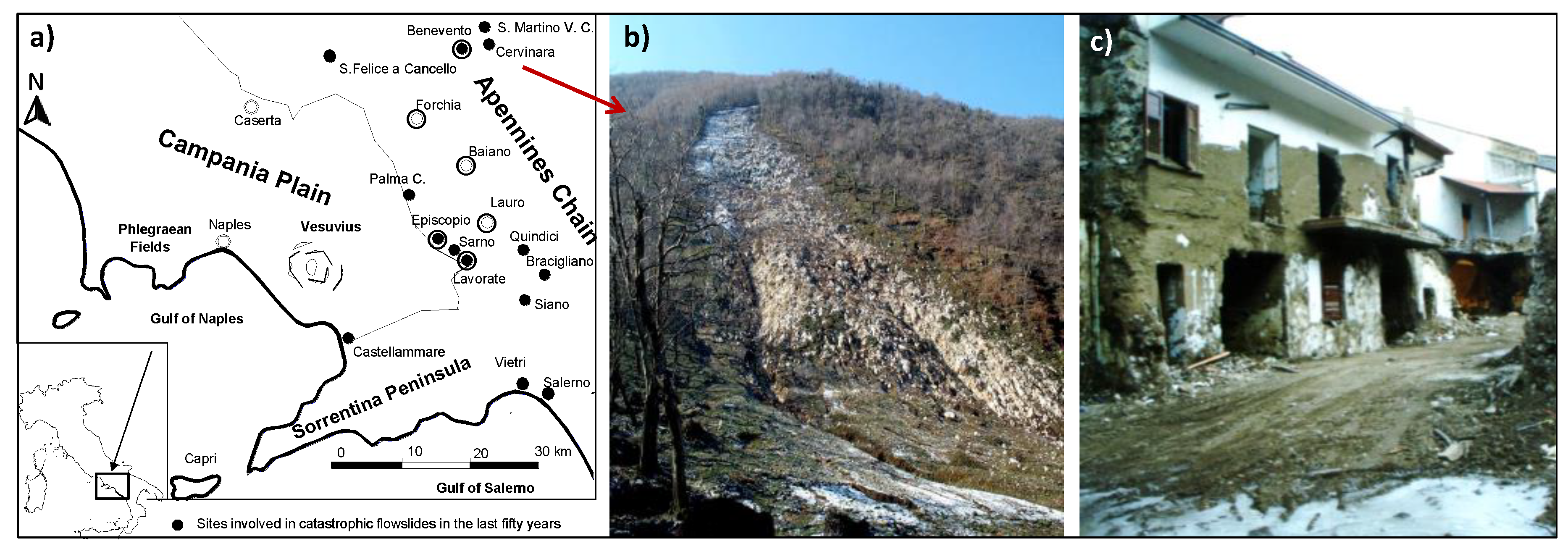
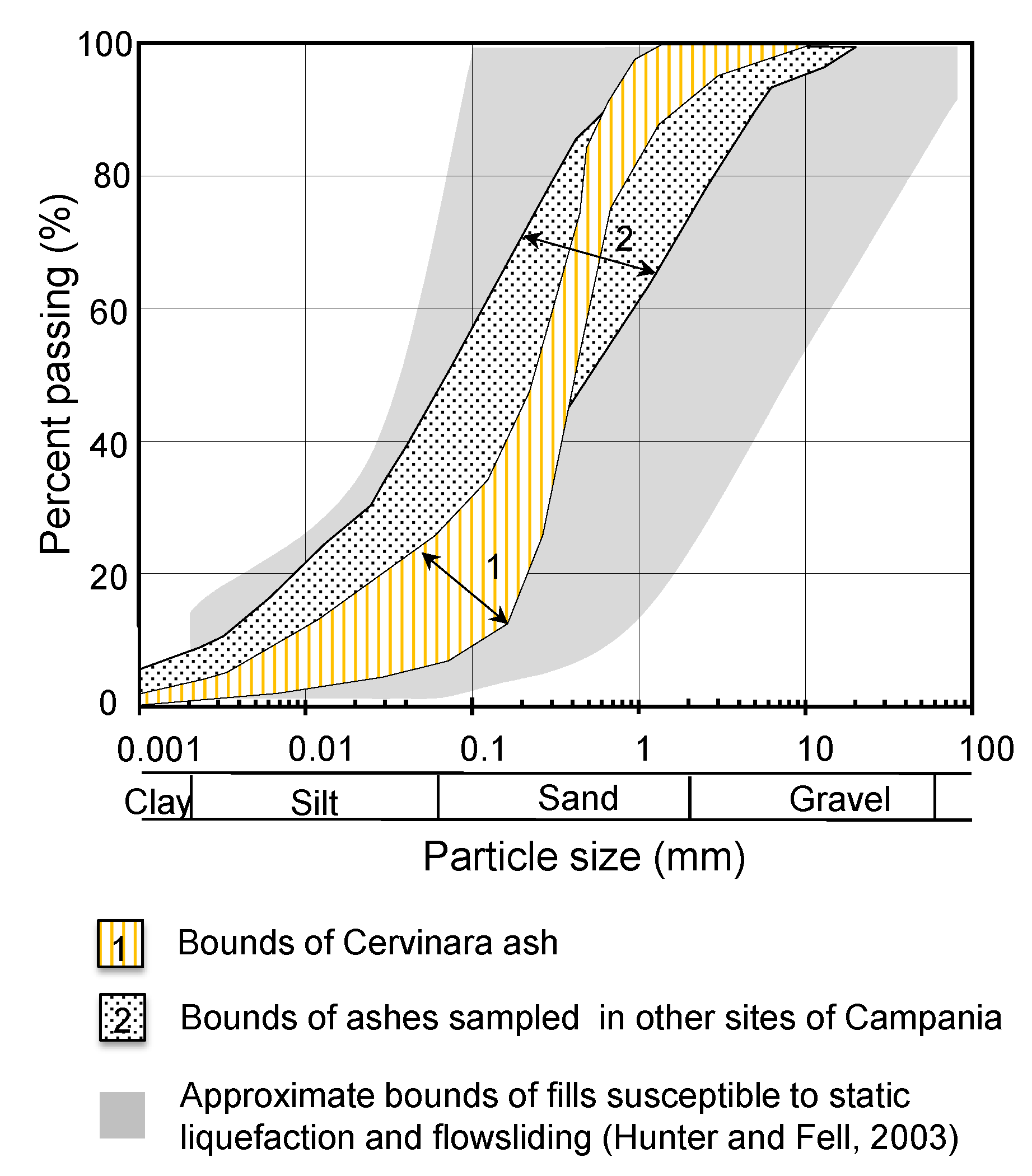

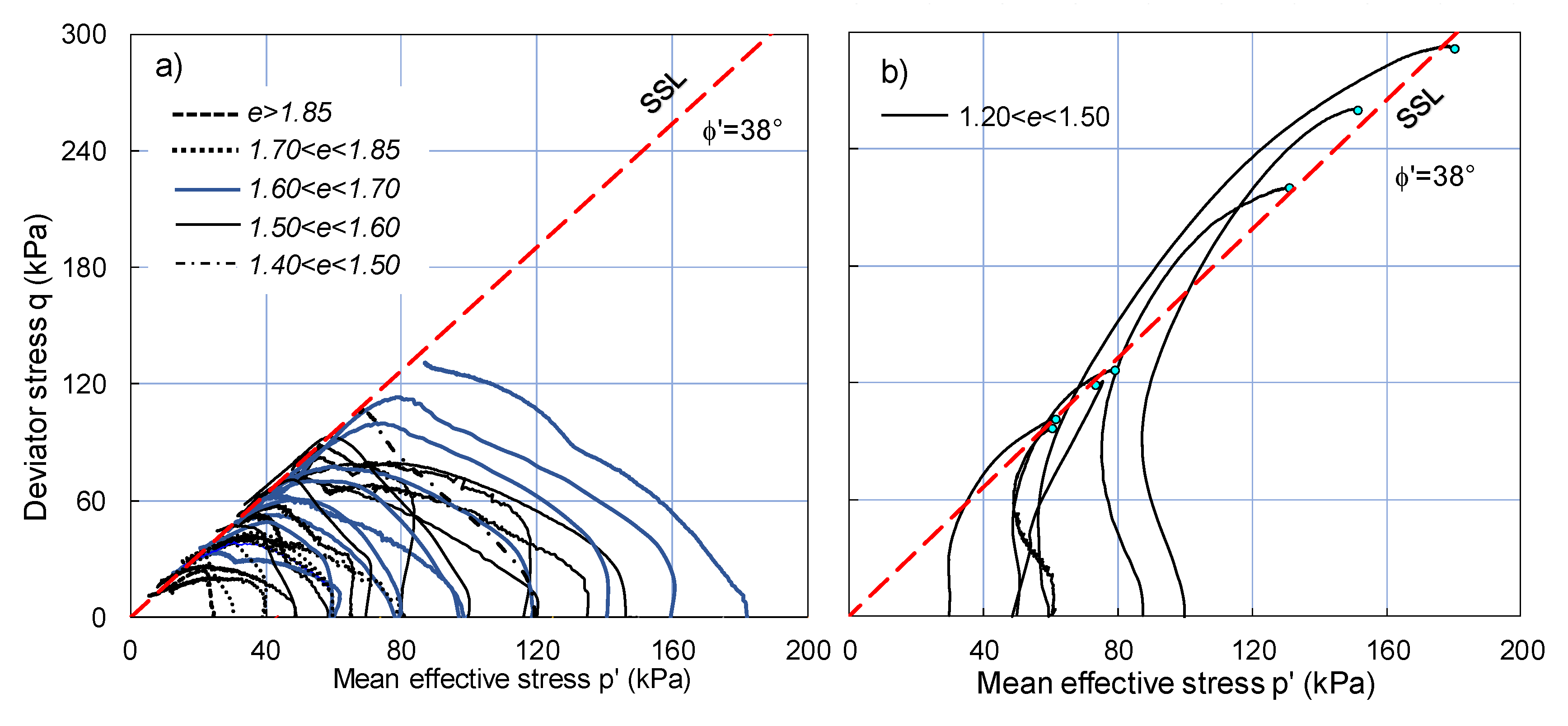
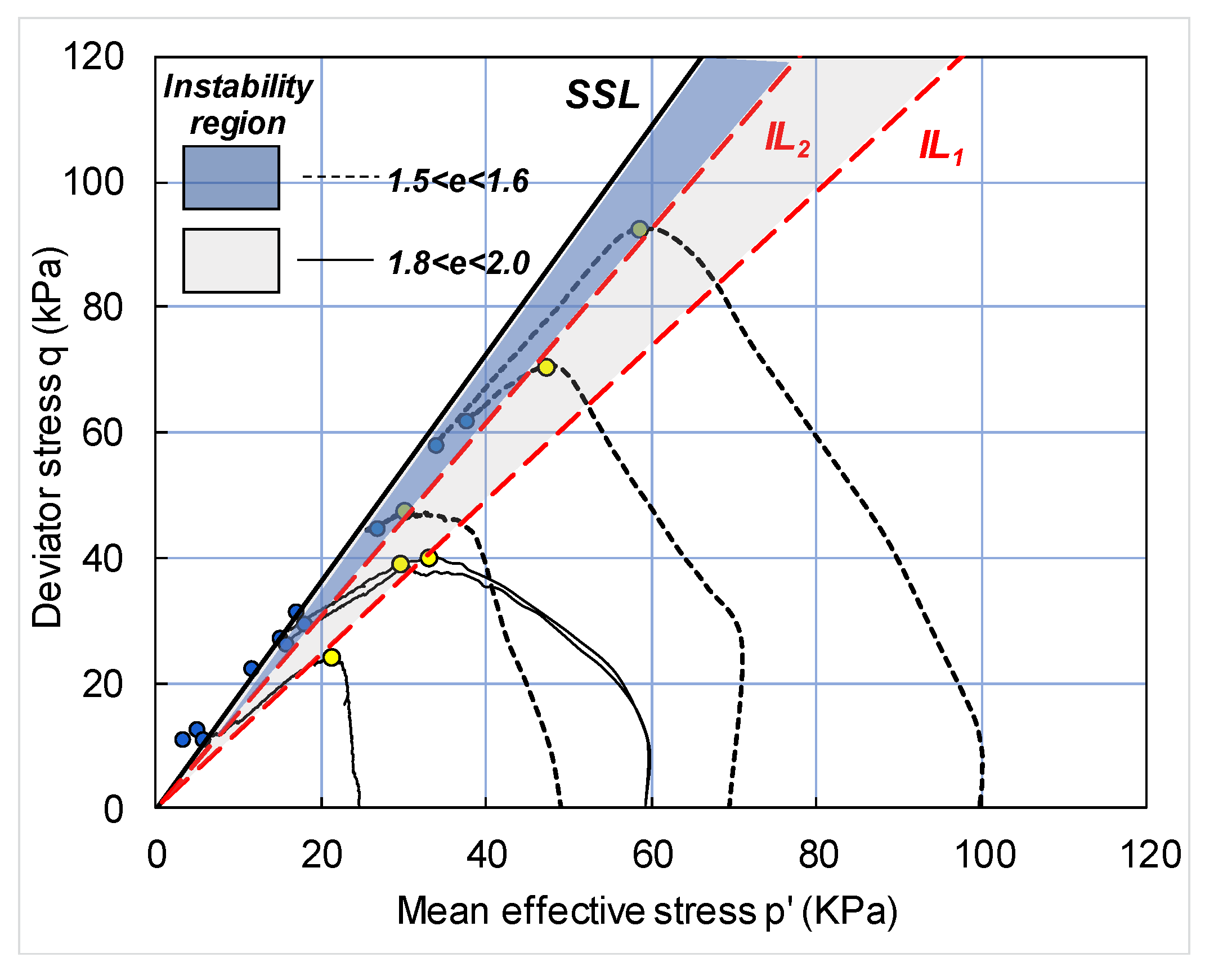

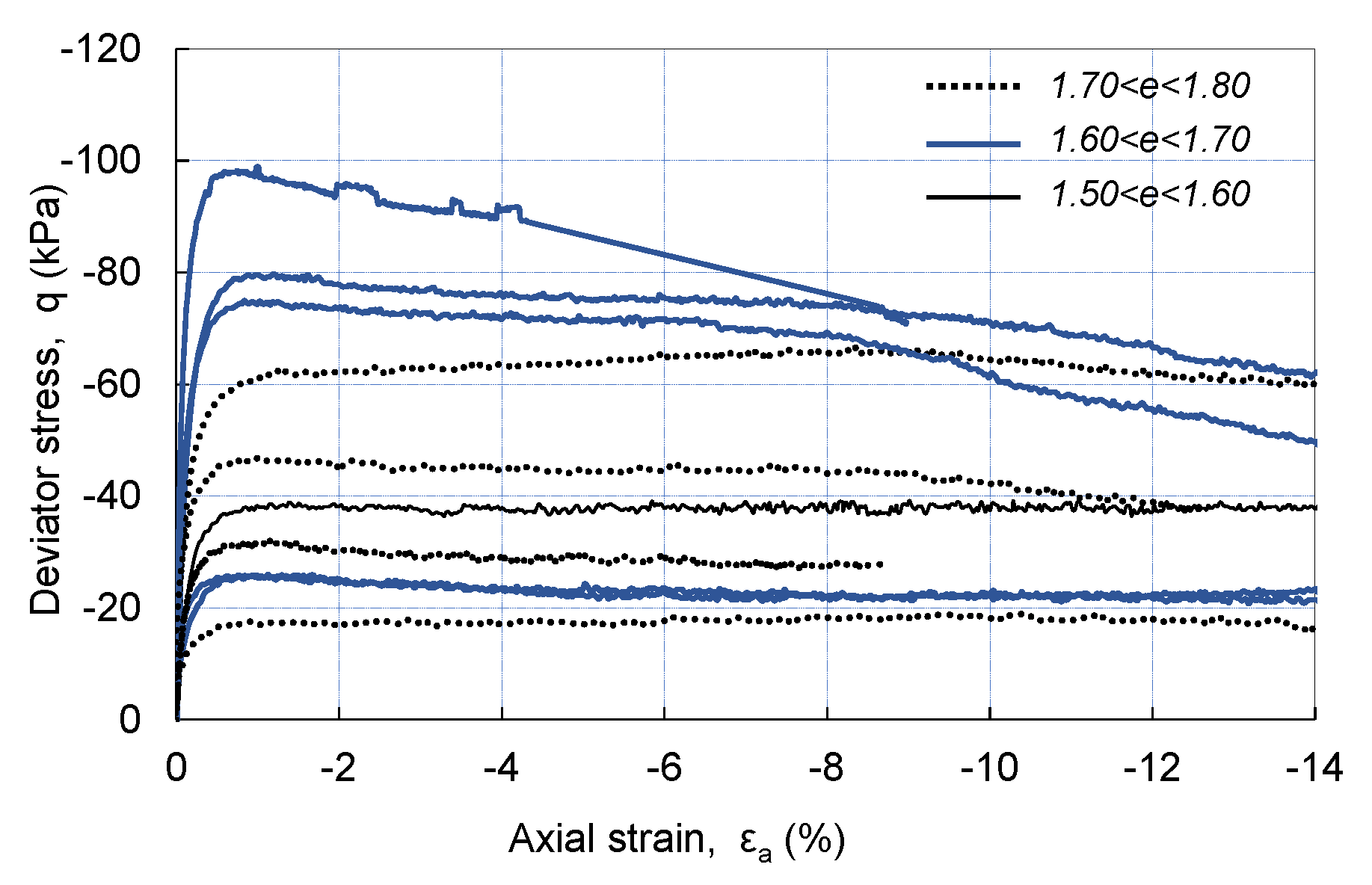


| Type of Test | Initial Conditions | End of Consolidation | ||||||
|---|---|---|---|---|---|---|---|---|
| Number of Tests | Stress-Path to Failure | Sr(%) | w | e | K | |||
| CIU_c | 7 | Compression | 33–65 | 0.19–0.31 | 1.19–1.55 | 1.20–1.46 | 30–100 | 1.0 |
| 7 | Compression | 39–86 | 0.27–0.50 | 1.45–1.88 | 1.40–1.50 | 30–120 | 1.0 | |
| 6 | Compression | 45–81 | 0.29–0.50 | 1.67–1.72 | 1.50–1.60 | 50–150 | 1.0 | |
| 8 | Compression | 50–72 | 0.32–0.57 | 1.68–1.93 | 1.60–1.70 | 60–180 | 1.0 | |
| 5 | Compression | 65–76 | 0.48–0.50 | 1.74-2.0 | 1.70–1.85 | 30–80 | 1.0 | |
| 3 | Compression | 50–59 | 0.39–0.48 | 2.09–2.14 | >1.80 | 25–60 | 1.0 | |
| CIU_e | 1 | Extension | 40 | 0.35 | 2.25 | 1.50–1.60 | 75 | 1.0 |
| 4 | Extension | 35–40 | 0.31–0.36 | 2.24–2.30 | 1.60–1.70 | 50–200 | 1.0 | |
| 5 | Extension | 34-38 | 0.30–0.34 | 2.21–2.30 | 1.70–1.80 | 40–175 | 1.0 | |
| CAU_c | 5 | Compression | 29–72 | 0.19–0.51 | 1.72–1.88 | 1.60–1.70 | 35–180 | 0.41–0.85 |
| 10 | Compression | 28–54 | 0.19–0.38 | 1.72–1.95 | 1.70–1.80 | 30–140 | 0.30–0.87 | |
| 7 | Compression | 43–56 | 0.31–0.41 | 1.91–2.08 | >1.80 | 40–90 | 0.33–0.54 | |
© 2020 by the authors. Licensee MDPI, Basel, Switzerland. This article is an open access article distributed under the terms and conditions of the Creative Commons Attribution (CC BY) license (http://creativecommons.org/licenses/by/4.0/).
Share and Cite
Picarelli, L.; Olivares, L.; Lampitiello, S.; Darban, R.; Damiano, E. The Undrained Behaviour of an Air-Fall Volcanic Ash. Geosciences 2020, 10, 60. https://doi.org/10.3390/geosciences10020060
Picarelli L, Olivares L, Lampitiello S, Darban R, Damiano E. The Undrained Behaviour of an Air-Fall Volcanic Ash. Geosciences. 2020; 10(2):60. https://doi.org/10.3390/geosciences10020060
Chicago/Turabian StylePicarelli, Luciano, Lucio Olivares, Salvatore Lampitiello, Reza Darban, and Emilia Damiano. 2020. "The Undrained Behaviour of an Air-Fall Volcanic Ash" Geosciences 10, no. 2: 60. https://doi.org/10.3390/geosciences10020060
APA StylePicarelli, L., Olivares, L., Lampitiello, S., Darban, R., & Damiano, E. (2020). The Undrained Behaviour of an Air-Fall Volcanic Ash. Geosciences, 10(2), 60. https://doi.org/10.3390/geosciences10020060








